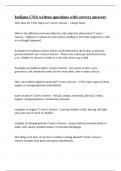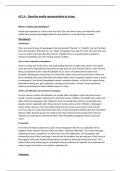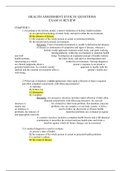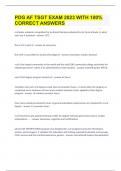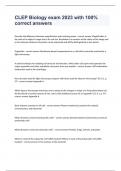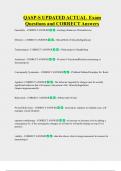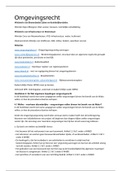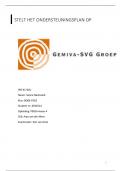Chapter 11
SLK 110
The Nature of Personality
● Personality is a complex hypothetical construct that has been defined in various
ways.
Defining : Consistency and Distinctiveness
● A person with an optimistic personality.
○ Indicates that the person has a fairly consistent tendency to behave in a
cheerful, hopeful, enthusiastic way, looking at the bright side of things across
a wide variety of situations.
■ Although no one is entirely consistent in behaviour, this quality of
consistency across situations lies at the core of the concept of
personality.
● Distinctiveness is also central to the concept of personality.
● Personality is used to explain why everyone does not act the same way in similar
situations.
● The concept of personality is used to explain: g
1. The stability in a person’s behaviour over time and across
situations (consistency).
2. The behavioural differences among people reacting to the same
situation (distinctiveness).
● We can combine these ideas into the following definition:
○ Personality: Refers to an individual’s unique set of consistent behavioural
traits.
1
,Personality Traits: Dispositions and Dimensions
● A personality trait: Is a durable disposition to behave in a particular way in a
variety of situations.
● Adjectives such as honest, dependable, moody, impulsive, suspicious, domineering
and friendly describe dispositions that represent personality traits.
● Believed that some traits are more basic than others.
Eg. A person’s tendency to be impulsive, restless, irritable, boisterous and
impatient might all be derived from a more basic tendency to be excitable.
● When taking on the challenge of identifying the basic traits that form the core of
personality.
○ Theorists depend on ‘factor analysis’.
● Factor analysis: Correlations among many variables are analysed to identify closely
related clusters of variables.
○ If the measurements of a number of variables (in this case, personality traits)
correlate highly with one another, the assumption is that a single factor is
influencing all of them.
○ Factor analysis is used to identify these hidden factors.
○ Hidden factors are viewed as basic, higher-order traits that determine less
basic, more specific traits.
● The most influential model of personality structure has been the five-factor model
of personality.
2
,The Five-Factor Model of Personality Traits
1. Extraversion:
● Characterised as outgoing, sociable, upbeat, friendly, assertive and
gregarious.
● Have a positive outlook on life and are motivated to pursue social
contact, intimacy and interdependence
2. Neuroticism:
● Anxious, hostile, self-conscious, insecure and vulnerable.
● Exhibit impulsiveness and emotional instability.
3. Openness to Experience:
● Associated with curiosity, flexibility, imaginativeness, intellectual
pursuits, interests in new ideas and unconventional attitudes.
● These people tend to be tolerant of ambiguity.
4. Agreeableness:
● Warm, sympathetic, trusting, compassionate, cooperative, modest
and straightforward.
● Correlated with empathy and helping behaviour.
5. Conscientiousness:
● Diligent, well-organised, punctual and dependable.
● Associated with strong self-discipline and the ability to regulate
oneself effectively.
3
, ● Females tend to score slightly higher than males on agreeableness and on
neuroticism.
○ Probably reflect the operation of both genetic and environmental
influences.
Eg. Higher marks in university are associated with higher conscientiousness, mainly
because conscientious students tend to work harder
● Openness to experience may promote creative achievement in the arts.
● Extraversion and conscientiousness are positive predictors of occupational
achievement, whereas neuroticism is a negative predictor.
● Agreeableness is negatively associated with income, especially among men.
○ Agreeableness is a predictor of prosocial behaviour – that is, a willingness to
help others in need – probably because it fosters empathy for those in need.
● The absolute levels of various traits may not be as important as how well individuals’
traits fit with the demands of a specific job.
○ When there was a good fit between individuals’ scores on the Big Five traits
and the personality traits required for specific jobs (as rated by experts),
people enjoyed greater job success, as measured by increased income.
● The Big Five traits are related to health and mortality.
4
SLK 110
The Nature of Personality
● Personality is a complex hypothetical construct that has been defined in various
ways.
Defining : Consistency and Distinctiveness
● A person with an optimistic personality.
○ Indicates that the person has a fairly consistent tendency to behave in a
cheerful, hopeful, enthusiastic way, looking at the bright side of things across
a wide variety of situations.
■ Although no one is entirely consistent in behaviour, this quality of
consistency across situations lies at the core of the concept of
personality.
● Distinctiveness is also central to the concept of personality.
● Personality is used to explain why everyone does not act the same way in similar
situations.
● The concept of personality is used to explain: g
1. The stability in a person’s behaviour over time and across
situations (consistency).
2. The behavioural differences among people reacting to the same
situation (distinctiveness).
● We can combine these ideas into the following definition:
○ Personality: Refers to an individual’s unique set of consistent behavioural
traits.
1
,Personality Traits: Dispositions and Dimensions
● A personality trait: Is a durable disposition to behave in a particular way in a
variety of situations.
● Adjectives such as honest, dependable, moody, impulsive, suspicious, domineering
and friendly describe dispositions that represent personality traits.
● Believed that some traits are more basic than others.
Eg. A person’s tendency to be impulsive, restless, irritable, boisterous and
impatient might all be derived from a more basic tendency to be excitable.
● When taking on the challenge of identifying the basic traits that form the core of
personality.
○ Theorists depend on ‘factor analysis’.
● Factor analysis: Correlations among many variables are analysed to identify closely
related clusters of variables.
○ If the measurements of a number of variables (in this case, personality traits)
correlate highly with one another, the assumption is that a single factor is
influencing all of them.
○ Factor analysis is used to identify these hidden factors.
○ Hidden factors are viewed as basic, higher-order traits that determine less
basic, more specific traits.
● The most influential model of personality structure has been the five-factor model
of personality.
2
,The Five-Factor Model of Personality Traits
1. Extraversion:
● Characterised as outgoing, sociable, upbeat, friendly, assertive and
gregarious.
● Have a positive outlook on life and are motivated to pursue social
contact, intimacy and interdependence
2. Neuroticism:
● Anxious, hostile, self-conscious, insecure and vulnerable.
● Exhibit impulsiveness and emotional instability.
3. Openness to Experience:
● Associated with curiosity, flexibility, imaginativeness, intellectual
pursuits, interests in new ideas and unconventional attitudes.
● These people tend to be tolerant of ambiguity.
4. Agreeableness:
● Warm, sympathetic, trusting, compassionate, cooperative, modest
and straightforward.
● Correlated with empathy and helping behaviour.
5. Conscientiousness:
● Diligent, well-organised, punctual and dependable.
● Associated with strong self-discipline and the ability to regulate
oneself effectively.
3
, ● Females tend to score slightly higher than males on agreeableness and on
neuroticism.
○ Probably reflect the operation of both genetic and environmental
influences.
Eg. Higher marks in university are associated with higher conscientiousness, mainly
because conscientious students tend to work harder
● Openness to experience may promote creative achievement in the arts.
● Extraversion and conscientiousness are positive predictors of occupational
achievement, whereas neuroticism is a negative predictor.
● Agreeableness is negatively associated with income, especially among men.
○ Agreeableness is a predictor of prosocial behaviour – that is, a willingness to
help others in need – probably because it fosters empathy for those in need.
● The absolute levels of various traits may not be as important as how well individuals’
traits fit with the demands of a specific job.
○ When there was a good fit between individuals’ scores on the Big Five traits
and the personality traits required for specific jobs (as rated by experts),
people enjoyed greater job success, as measured by increased income.
● The Big Five traits are related to health and mortality.
4


